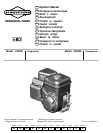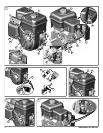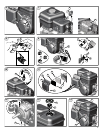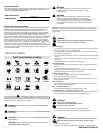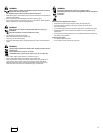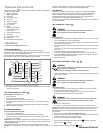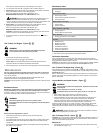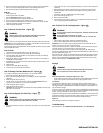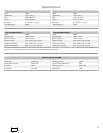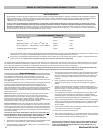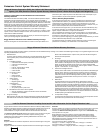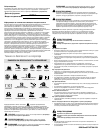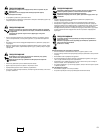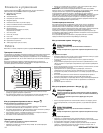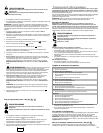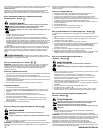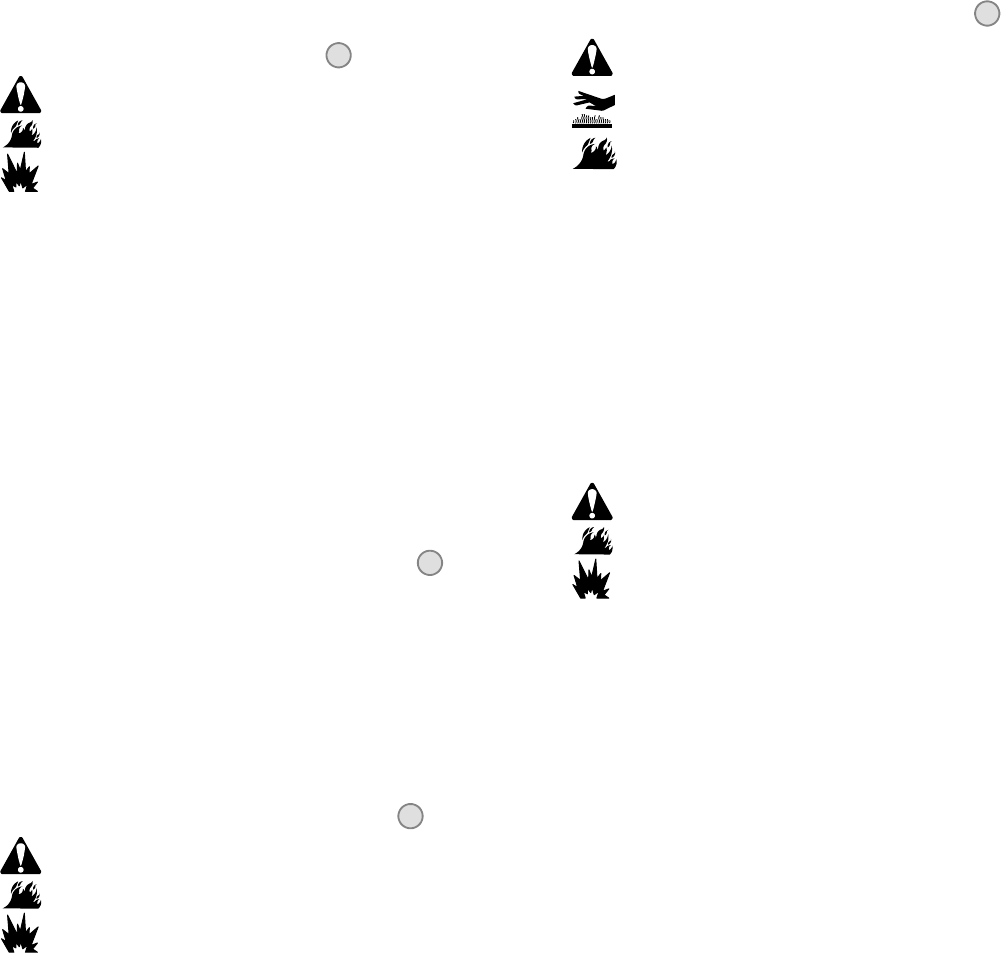
8
BRIGGSandSTRATTON.COM
2. Remove the oil drain plug (B, Figure 9). Drain the oil into an approved receptacle.
Note: Any of the oil drain plugs (C) shown may be installed in the engine.
3. After the oil has drained, install and tighten the oil drain plug.
Add oil
• Place engine level.
• Clean the oil fill area of any debris.
• See the Specifications section for oil capacity.
1. Remove the dipstick (D) and wipe with a clean cloth.
2. Pour the oil slowly into the engine oil fill (E). Fill to point of overflowing.
3. Install the dipstick but do not screw in. Remove and check the oil level. Oil level
should be at the FULL mark (F) on the dipstick.
4. Install and tighten the dipstick.
How To Service The Air Filter - Figure
11
WARNING
Gasoline and its vapors are extremely flammable and explosive.
Fire or explosion can cause severe burns or death.
• Never start or run the engine with the air cleaner assembly or the air filter removed.
CAUTION: Do not use pressurized air or solvents to clean the filter. Pressurized air can
damage the filter and solvents will dissolve the filter.
The air cleaner system uses a pleated filter with an optional pre-cleaner. The pre-cleaner
can be washed and reused.
Flat Air Filter
1. Loosen the fastener (D) that holds the cover (A). See Figure 11.
2. Open the cover and remove the pre-cleaner (C) and the filter ( B).
3. To loosen debris, gently tap the filter on a hard surface. If the filter is excessively
dirty, replace with a new filter.
4. Wash the pre-cleaner in liquid detergent and water. Then allow it to thoroughly air
dry. Do not oil the pre-cleaner.
5. Assemble the dry pre-cleaner to the filter with the lip (G) of the pre-cleaner on the
bottom of the filter pleats.
6. Install the filter.
7. Install the cover tabs (E) into the slots (F).
8. Close the cover and secure with the fastener.
How To Change The Gear Reduction Oil - Figure
12
If your engine is equipped with a gear reduction unit, service as follows.
1. Remove the oil fill plug (B) and the oil level plug (C).
2. Remove the oil drain plug (A, Figure 12) and drain the oil into a n appropriate
receptacle.
3. Install and tighten the oil drain plug.
4. To refill, slowly pour gear lube into the oil fill hole (see Specifications section).
Continue to pour until the oil runs out of the oil level hole.
5. Install and tighten the oil level plug.
6. Install and tighten the oil fill plug.
Important: The oil fill plug has a vent hole (D) and must be installed on the top of the
gear case cover as shown.
How To Clean/Replace The Fuel Filter - Figure
13
WARNING
Gasoline and its vapors are extremely flammable and explosive.
Fire or explosion can cause severe burns or death.
• Keep gasolineaway from sparks, openflames, pilot lights, heat,and other ignition
sources.
• Check fuel lines, tank, cap, and fittings frequently for cracks or leaks. Replace if
necessary.
• Before replacing the fuel filter, drain the fuel tank or close the fuel shut-off valve.
• Replacement parts must be the same and installed in the same position as the
original parts.
• If fuel spills, wait until it evaporates before starting engine.
1. Remove the fuel cap (A, Figure 13).
2. Remove the fuel filter (B).
3. If the fuel filter is dirty, clean or replace it. If you replace the fuel filter, make sure to
use an original equipment replacement filter.
How To Clean The Air Cooling System - Figure
14
Running engines produce heat. Engine parts, especially muffler, become
extremely hot.
Severe thermal burns can occur on contact.
Combustible debris, such as leaves, grass, brush, etc. can catch fire.
WARNING
• Allow muffler, engine cylinder and fins to cool before touching.
• Remove accumulated debris from muffler area and cylinder area.
CAUTION: Do not use water to clean the engine. Water could contaminate t he fuel
system. Use a brush or dry cloth to clean the engine.
This is an air cooled engine. Dirt or debris can restrict air flow and cause the engine to
overheat, resulting in poor performance and reduced engine life.
Use a brush or dry cloth to remove debris from the finger guard (A). Keep linkage,
springs and controls (B) clean. Keep the area around and behind the muffler (C)freeof
any combustible debris (Figure 14).
After a period of time, debris can accumulate in the cylinder cooling fins and cause the
engine to overheat. This debris cannot be removed without partial disassembly of the
engine. Have a Briggs & Stratton Authorized Dealer inspect and clean the air cooling
system as recommended in the Maintenance Chart.
Storage
WARNING
Gasoline and its vapors are extremely flammable and explosive.
Fire or explosion can cause severe burns or death.
When Storing Gasoline Or Equipment With Fuel In Tank
• Store away from furnaces, stoves, water heaters or other appliances that have pilot
lights or other ignition sources because they can ignite gasoline v apors.
Fuel System
Fuel can become stale when stored over 30 days. Stale fuel causes acid and gum
deposits to form in the fuel system or on essential carburetor parts. To keep fuel fresh,
use Briggs & Stratton FRESH START
®
fuel stabilizer, available as a liquid additive or a
drip concentrate cartridge.
There is no need to drain gasoline from the engine if a fuel stabilizer is added according
to instructions. Run the engine for 2 minutes to circulate the stabilizer throughout the f uel
system. The engine and fuel can then be stored up to 24 months.
If gasoline in the engine has not been treated with a fuel stabilizer, it must be drained into
an approved container. Run the engine until it stops from lack of fuel. The use of a fuel
stabilizer in the storage container is recommended to maintain freshness.
Engine Oil
While the engine is still warm, change the engine oil.
Troubleshooting
Need Assistance? Go to BRIGGSandSTRATTON.COM or call 1-800-233-3723.



